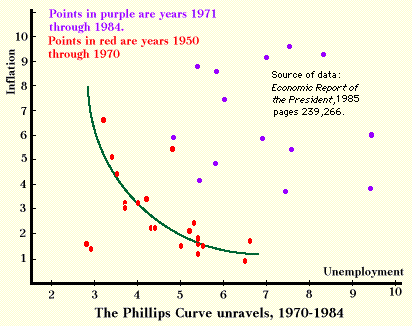 WellSpyder, on 2012-August-13, 11:01, said:
WellSpyder, on 2012-August-13, 11:01, said:
I don't really want to pick up on all the points in your post, and I agree with quite a bit of what you say, but I suspect the fundamental reason why we don't necessarily agree on the appropriate policy response lies in the final sentence in your para above. How do you propose to lower the inflation rate again?? Do you think this will simply happen by the central bank reducing the rate of monetary expansion in the economy, with no consequences for the real economy?? Or is it more likely to require an increase in interest rates to reduce demand, and put downward pressure on inflation by increasing unemployment again, in order to reduce inflationary expectations again?
The point is that the philips curve is not the same shape at full employment as it is during a recession, so these procedures are not symmetrical. Near full employment it is shallower, so reducing inflation by one percent near full employment will have less of an effect on employment than one percent now, where we are on the steep part of the curve.
Moreover, even if they were symmetric, you can lower it more slowly, so that you stay at full employment, and get an overall increase in net jobs. Its really just a variation on the fiscal policy argument: fiscal policy raises demand a lot now, and reduces it a little over a long period in the future, through consumption smoothing, and so stimulus during a recession does lead to a net increase in jobs. Of course, that must be true, as fiscal and monetary stimulus are essentially identical.
We can also see this through a less abstract lens: at full employment, there is a demand for labor, and generally the economy wants more workers than it has available, so small negative shifts at full employment are easily absorbed.
On final point, if inflation expectations in the long term are 2%, returning to the expected does not have any effect. What you say above is something which is true by degree. If we moved inflation expectations by having higher inflation for several decades, then lower inflation would be contractionary, but in reality a few years of higher than 2% inflation is unlikely to move the expectation.
Okay really final point here. If you are worried about longterm inflation expectations, you should be worried that expectations of inflation are already disachnchored. FOr decades the us 30 year treasuries have had an implied inflation rate between 2 and 2.5 %. But now we are seeing significant volatitility, check it out
here. In late 2010, for example, implied inflation expectation for the US was down to 1%. Which is mental. The market no longer knows whether to believe that the Fed is actually targeting a 2% inflation, and the result is unprecedented volatility in long term expecations. We have already dis-anchored expectations, to the downside, which, by your own admission, is contractionary.

The Fed, by having lower than expected inflation, is engaging in contractionary monetary policy, despite the high unemployment. This is a scandal.
The physics is theoretical, but the fun is real. - Sheldon Cooper
 phil_20686, on 2012-August-13, 10:16, said:
phil_20686, on 2012-August-13, 10:16, said:
 Help
Help







